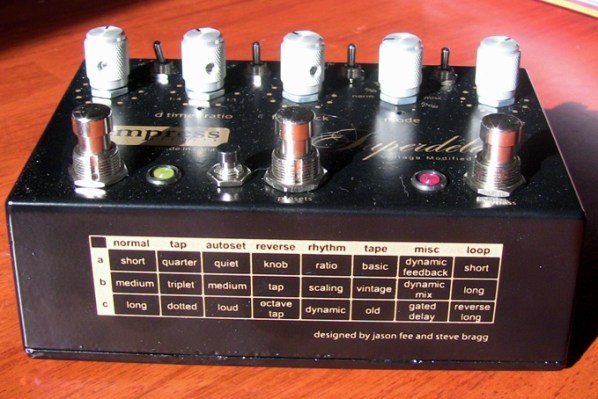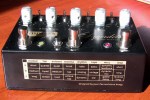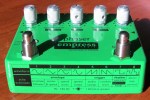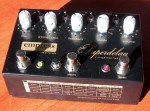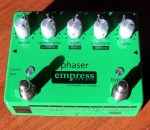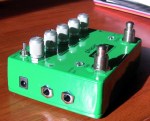I love analog tech and I love analog sound. That’s why I wrote up these two basic reviews of two Empress analog pedals for guitarists sick of bleeps and bloops and color LCD read-outs. I added a few video demos, as well, but I was able to play with this gear for a while in my own home studio and came away quite pleased.
Empress Phaser Pedal
Empress’ phaser pedal packs a lot of features in a small package. Between the 2, 3 or 4-stage modes, several submodes, and overall quality in both hardware and sound fidelity, this pedal is one of the better offerings available.
The pedal itself is compact, but it’s very durable, and even the knobs have a nice weight to them. You have your standard input/output jacks, as well as an additional input for an expression pedal and another one to connect an external audio signal. There are three basic operating modes: knob, tap, and auto. Knob mode lets you set the speed and speed range. In tap mode, you can use your foot to tap out a tempo, and there is a ratio knob to set the speed of the phasing effect. Auto mode is a bit different; the effects parameters actually changed based on how you’re playing.
Within auto mode, there are eight different submodes, such as Phase Shift Follows Envelope, LFO On Envelope, and Rhythm Mode. Each allows for various levels of manipulation to create surprisingly distinct sounds. My personal favorite is Speed Follows Envelope, Sine Waveform, where the phasing effect increases as the instrument signal gets louder.
I’ve had the opportunity to record several songs using this pedal, and compared to a variety of other pedals I’ve used, the sound this one produces is the best. There is absolutely no loss in fidelity…..I’ve tested in in several environments, plugging it directly into an 8-track recorder, going through an amp, and comparing the output to tracks where the pedal wasn’t used. The effects come through clearly, and there isn’t any of the volume “phasing” that impacts a lot of phaser pedals, where the volume can spike or become disjointed.
There seem to be an infinite number of configurations you can come up with, so it won’t get old quickly. That said, it’s disappointing that you can’t save any custom presets so you can easily go back to a favorite configuration. That’s one small complaint for an otherwise outstanding pedal.
Empress SuperDelay Pedal
The Vintage Modified SuperDelay effects pedal from Empress takes your standard delay effects and incorporates a lot of unique features that you won’t find elsewhere. Empress already has a SuperDelay pedal available, but this one incorporates a lot of grittier, more analog-based sounds.
To start with, the hardware is solid; it would take a lot to damage it. The basic sound quality is very good. I experienced little to no noise in my recordings, and the tone is as crisp as when I have my guitar plugged directly into my amp. There is an additional input for an expression pedal as well.
There are eight different main modes ranging from tap, reverse, rhythm, and tape mode. There are also three sub-modes for each main mode. The sub-modes don’t do the same thing for each main mode. They are tailored for each mode, which allows for an incredible range of sounds you can get out of this.
For example, reverse mode does what it should, reverses the delayed signal. Sub-mode A controls how long each reversed segment of audio lasts. Sub-mode B allows you to set the length of reversed segments by hitting the TAP switch. In Sub-mode C, hitting the TAP switch will play back reversed segments in double-tempo.
Of course, separate from the modes and sub-modes are other controls, for the mix, ratio, feedback, and overall volume. The amount of customization you can do will keep you busy for a while, unless you simply find one favorite sounds and use that exclusively. For the adventurous musicians, you can feel free to experiment all you want and save up to eight user defined presets. Not all of Express’ pedals offer this feature, and for this particular model, it’s a must-have.
There isn’t much to complain about here. The delay effect might be an acquired taste for those who haven’t tried it before. But the comprehensive amount of available customizations and quality of the Vintage Modified should make anyone a fan.
Rick Barr is a programmer and musician from Columbus, Ohio.
